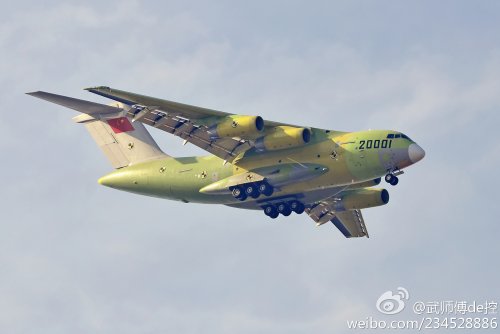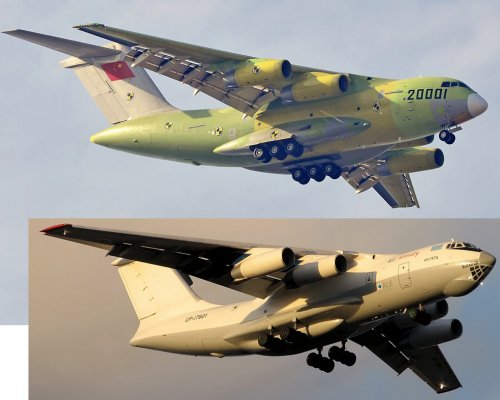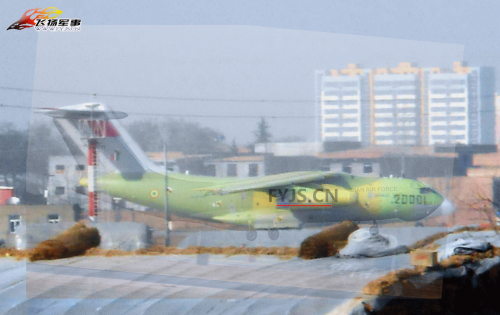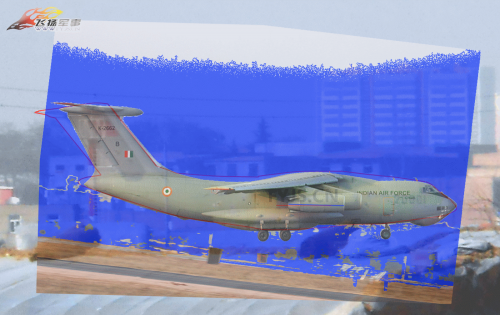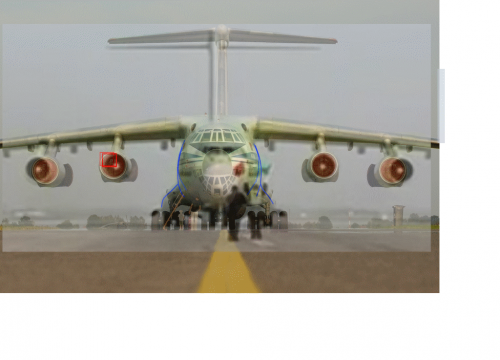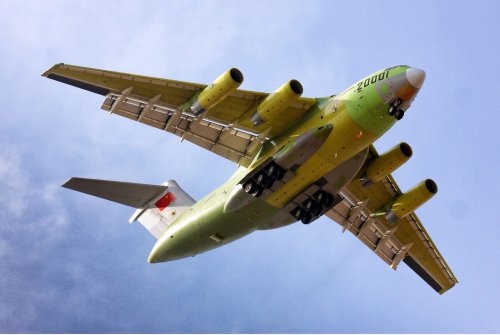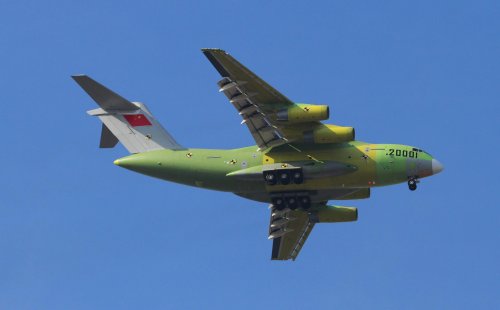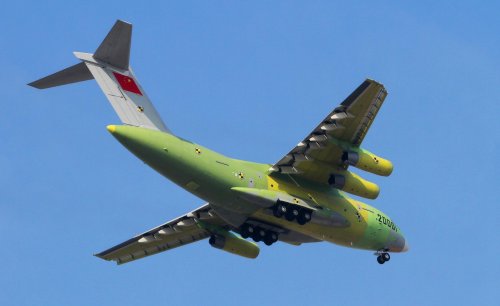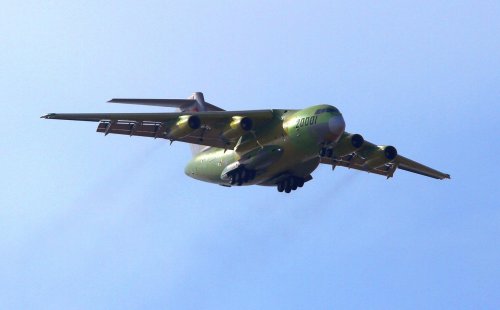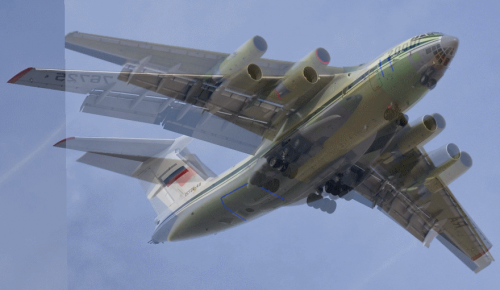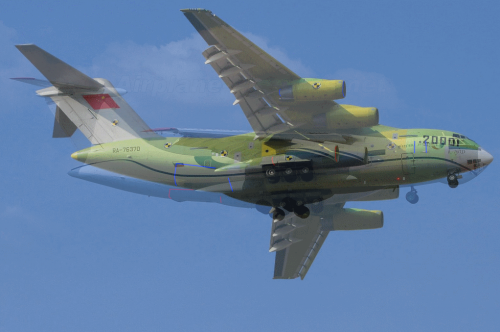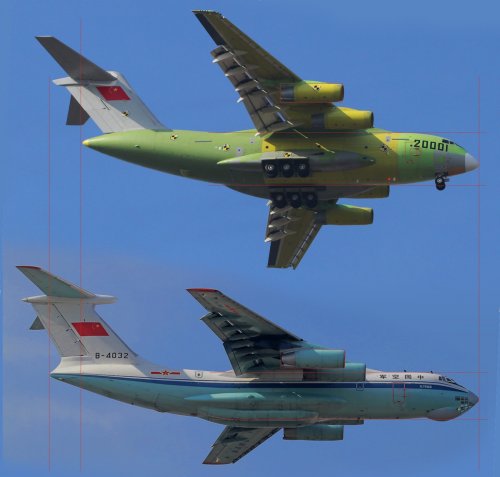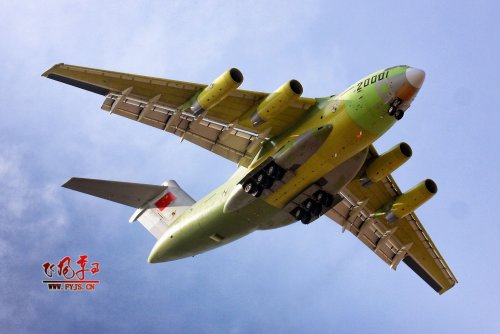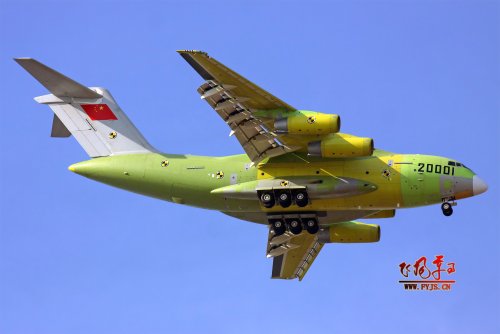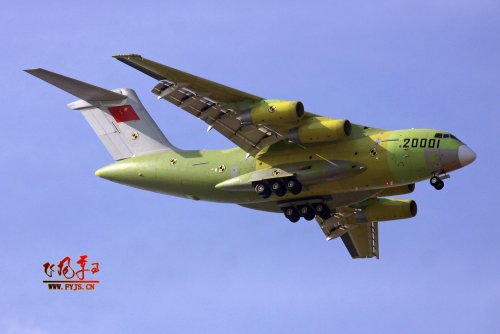You are using an out of date browser. It may not display this or other websites correctly.
You should upgrade or use an alternative browser.
You should upgrade or use an alternative browser.
XAC Y-20 Kunpeng
SlowMan
I really should change my personal text
- Joined
- 9 September 2012
- Messages
- 154
- Reaction score
- 8
Y-20's lack of STOL capability does prevent China from waging US-style wars due to China's inability to deliver cargo to frontline temporary airfields; Chinese cargo planes can land only when "invited" to use first class airports/airfields by the host country.Bill Walker said:If the Y-20 is limited to "civil airline runways" it could still play an important part in these types of deployments outside of China.
It is indeed smaller. And Y-20 doesn't have C-17's thrust reverser either.Deino said:No, I don't think so and to admit I simply posted it in regard to the comment/discussion on the Y-20's flaps ... otherwise I think it's smaller than the C-17.
http://www.youtube.com/watch?v=GNRXAHasFvk
- Joined
- 27 December 2005
- Messages
- 17,131
- Reaction score
- 22,975
1) Pretty much every transport and airliner has thrust reversers. Il-76 has thrust reversers with the same D-30KP engine. How specifically did you ascertain that Y-20 doesn't have them?
2) Its a prototype
3) The definitive version will use a totally different engine
So please stop with the "I can tell everything about an aircraft's operational roles from a grainy photo' BS.
2) Its a prototype
3) The definitive version will use a totally different engine
So please stop with the "I can tell everything about an aircraft's operational roles from a grainy photo' BS.
SlowMan said:Y-20's lack of STOL capability does prevent China from waging US-style wars due to China's inability to deliver cargo to frontline temporary airfields; Chinese cargo planes can land only when "invited" to use first class airports/airfields by the host country.
And as previously asked: just how often does the US (or anyone else for that matter) really use that capability??
Anyway, if that was really a limiting issue in a scenario, China (or once again others) don't need to worry about an invite - they could land in a nearby country or more likely, use helicopters or paratroops or other tactical transports to capture a suitable runway for use. Therefore, speculating about the Y-20's supposed capabilities and then making wide-ranging ascertains regarding what it will allow China to do/not do is not only presumptuous given the extreme lack of details, but also shows a distinct lack of realistic appreciation of how operations may/may not be conducted.
yasotay said:It is a nice looking aircraft. I did notice in the video that a couple of seconds after landing there was a lot of tail shake going on. Is this normal?
Well, I am sure someone here will say that it is evidence of poor structural design...though I suspect it might just be evidence of a slightly rough set down, or maybe a little wobble induced by the pilot...
GTX said:yasotay said:It is a nice looking aircraft. I did notice in the video that a couple of seconds after landing there was a lot of tail shake going on. Is this normal?
Well, I am sure someone here will say that it is evidence of poor structural design...though I suspect it might just be evidence of a slightly rough set down, or maybe a little wobble induced by the pilot...
Yep
http://www.youtube.com/watch?v=8q7NIa2ItL8
Bill Walker
Per Ardua ad Nauseum
Tail shake (short term) is not uncommon right after a hard touch down. Tail shake (long term) is often a result of disturbed airflow caused by thrust reversers. The YouTube video a few posts up clearly shows thrust reversers being used on the first flight.
- Joined
- 27 March 2006
- Messages
- 1,850
- Reaction score
- 1,541
Bill Walker said:Tail shake (short term) is not uncommon right after a hard touch down. Tail shake (long term) is often a result of disturbed airflow caused by thrust reversers. The YouTube video a few posts up clearly shows thrust reversers being used on the first flight.
Yes.
You can see them deploy at 0:38 onwards as the Y-20 lands. (post 76 by Fightingirish)
In fact, you don't even have to play the video, as it is obvious on the image of the video still for those who actually want to see it.
SlowMan
I really should change my personal text
- Joined
- 9 September 2012
- Messages
- 154
- Reaction score
- 8
Y-20 doesn't have C-17's "special" thrust reverser, which reverses the thrust of turbine as well as the bypassed air.PaulMM (Overscan) said:1) Pretty much every transport and airliner has thrust reversers. Il-76 has thrust reversers with the same D-30KP engine. How specifically did you ascertain that Y-20 doesn't have them?
Maybe, Maybe not. If definitely won't be a Chinese engine for the first 10 years or so.3) The definitive version will use a totally different engine
That's like asking how often F-22 uses its supercruise. The answer is like once a year. But it's the STOL that separates the C-17 from all other cargo planes, and the Europeans went with turbo-prop to have a STOL capability.GTX said:And as previously asked: just how often does the US (or anyone else for that matter) really use that capability??
Why do you think the nearby country would grant Chinese the permission to land?Anyway, if that was really a limiting issue in a scenario, China (or once again others) don't need to worry about an invite - they could land in a nearby country
Furthermore, not being able to land near the frontline means a long ground logistic line and delays.
This does not resolve the issue of not being able to land cargo jets closer to frontline.or more likely, use helicopters or paratroops or other tactical transports to capture a suitable runway for use.
SlowMan said:
Maybe, Maybe not. If definitely won't be a Chinese engine for the first 10 years or so.
Well it's been said by state media over and over again that the final thing will use WS-20 rather than D-30.
Why 10 years? Do you know how far WS-20 is along in development?
This does not resolve the issue of not being able to land cargo jets closer to frontline.
That would be a problem, if that was the case. But there's nothing in these new higher res photos which tells me Y-20 isn't meant to be capable of operating from unprepared airfields.
- Joined
- 27 December 2005
- Messages
- 17,131
- Reaction score
- 22,975
WS-20 is a large fan engine using the WS-10 core. It shouldn't be terribly challenging - most of the tough parts of engine design are in the hot sections, which are going to be largely common to WS-10. Getting adequate reliability will be the key.
The design of the vertical tail, from what look like a double articulated rudder with a separate hinge line down the center of the rudder, to the basic shape of the stabilizer and rudder, to the design of the top end of the stabilizer that enclose the horizontal stabilizer trimming mechanism and elevator mechanism, seems to me like a remarkably exact duplicate of the vertical tail of the C-17.
- Joined
- 27 December 2005
- Messages
- 17,131
- Reaction score
- 22,975
I'm aware the Il-76 is slightly foreshortened here due to angles, but an interesting comparison using the identical engine to size them.
I think Y-20 is slightly shorter with a wider centre section. With D-30KP-2 it will be an improvement on Il-76 due to much more modern airframe. When engined with WS-20 it will be a better option than Il-476. Russia was hoping to sell them Il-476's but it seems to me that boat has sailed.
I think Y-20 is slightly shorter with a wider centre section. With D-30KP-2 it will be an improvement on Il-76 due to much more modern airframe. When engined with WS-20 it will be a better option than Il-476. Russia was hoping to sell them Il-476's but it seems to me that boat has sailed.
Attachments
- Joined
- 27 December 2005
- Messages
- 17,131
- Reaction score
- 22,975
Present your own comparison then. Do you disagree with something I said?
nope, no disagreement. I am sorry i forgot to compliment you for the effort, every effort for comparison if to be commended. That being said, even better image angles are available for comparison, for those people who can do a good comparison.
I am not sure i managed to do a 100% precise comparison, there may be several pixels of difference, and perhaps y20 should be a few pixels smaller, but here's my try which can surely be bettered by someone else.
I am not sure i managed to do a 100% precise comparison, there may be several pixels of difference, and perhaps y20 should be a few pixels smaller, but here's my try which can surely be bettered by someone else.
Attachments
- Joined
- 27 December 2005
- Messages
- 17,131
- Reaction score
- 22,975
Yep - that's pretty good. I chose the one I did simply as it was high enough resolution to see details of the engine nacelles.
- Joined
- 2 January 2006
- Messages
- 3,688
- Reaction score
- 4,136
Here is another comparison between two relatively similar angles. engines are to scale, then the overlays were moved so the nose and lower contour of the planes match.
Fuselage seems to be a bit shorther than il76, cargo ramp seems to be positioned a bit closer to the center compared to il76 but at the same time the whole front section of the plane seems to be more compact and the side doors are closer to cockpit, compared to il76. Overall, the length of the cargo cabin may be identical to il76, despite the shorther fuselage.
wing sweep angle also seems to be a bit less than on il76.
The second image is perhaps an even better match, fuselage angle wise, even though the rotation of the plane is obviously different.
It is interesting that on images that are from the side y20 seems longer than on images taken from perspective. Difference in length in this second pic is almost negligable, compared to il76.
Another thing to note, which i think supports the theory that cabin area starts closer to nose on y20 and ends a closer too, is the position of wingbox and landing gear. Both of those should ideally be placed very near to the center of mass and lift. And both are placed a bit closer to the nose than on il76, roughly by the similar amount the cargo ramp and nose doors are moved forward, comapred to il76.
Fuselage seems to be a bit shorther than il76, cargo ramp seems to be positioned a bit closer to the center compared to il76 but at the same time the whole front section of the plane seems to be more compact and the side doors are closer to cockpit, compared to il76. Overall, the length of the cargo cabin may be identical to il76, despite the shorther fuselage.
wing sweep angle also seems to be a bit less than on il76.
The second image is perhaps an even better match, fuselage angle wise, even though the rotation of the plane is obviously different.
It is interesting that on images that are from the side y20 seems longer than on images taken from perspective. Difference in length in this second pic is almost negligable, compared to il76.
Another thing to note, which i think supports the theory that cabin area starts closer to nose on y20 and ends a closer too, is the position of wingbox and landing gear. Both of those should ideally be placed very near to the center of mass and lift. And both are placed a bit closer to the nose than on il76, roughly by the similar amount the cargo ramp and nose doors are moved forward, comapred to il76.
Attachments
I sort of expected this comment, which is why I didn't shoot down that argument of yours even earlier - doing so at this point will demonstrate more clearly that you have no idea what you're talking about and would do well not to let your bias get in the way of the facts. As you correctly point out, compared to the civilian PW2000 and other *high-bypass ratio* turbofans, the F117 reverser is unique in that it deflects both core and bypass jets. So far so good, but have you thought a little bit about how those clam-shell reversers on the D-30 work? Hint, they do *exactly* the same thing, as the D-30 features mixed bypass and core streams exhausted through a common nozzle, which the reverser bucket operates on in its entirety. This system went out of fashion in favour of cascades on high-byass engines because of weight issues when scaled up to match and difficulty of applying it to separate bypass and core nozzles at all.SlowMan said:Y-20 doesn't have C-17's "special" thrust reverser, which reverses the thrust of turbine as well as the bypassed air.
Bottom line:
- From current imagery, it looks like the main landing gear has independent suspension for each wheel pair, indicating design for good operation from unprepared surfaces - similar to the An-70 and A400M, but unlike the Japanese C-2.
- The flap system is clearly large and complex, in direct contradiction to your assertions based on imagery that you should have known was incapable of supporting such a statement one way or the other.
- Your assessment of the thrust reverser system is also completely false - the D-30KP does in fact use both bypass and core jets for reverse thrust.
As a result, all your considerations about how the Y-20 would require more cooperation from the local authority in the theatre of operations are completely moot.
Irrelevant. According to established *facts*, your analysis of the Y-20's STOL capability has been *proven* to be completely wrong, so these arguments are founded on fatally flawed assumptions.SlowMan said:But it's the STOL that separates the C-17 from all other cargo planes, and the Europeans went with turbo-prop to have a STOL capability.
Why do you think the nearby country would grant Chinese the permission to land?
Furthermore, not being able to land near the frontline means a long ground logistic line and delays.
This does not resolve the issue of not being able to land cargo jets closer to frontline.
Agree completely - the Y-20 exposes very nicely just how big a folly the Il-476 actually is and may well do more damage to its international sales prospects than merely denying the Chinese market, especially if you consider that the Russian aircraft flew only four months earlier. In many ways, a Y-20-style airframe with PS-90A engines is what the Il-476 SHOULD have been if it was to have made any military sense whatsoever and what it COULD have been if it was not for a false sense of complacency in Russia. Though how urgent the requirement for a transport in this class could ever be for an air force with access to both An-70 and An-124s is debatable - all in all exactly the kind of politically motivated waste of money that Russia can ill afford if they want to stay competitive with China's deeper pockets in the long term.PaulMM (Overscan) said:With D-30KP-2 it will be an improvement on Il-76 due to much more modern airframe. When engined with WS-20 it will be a better option than Il-476. Russia was hoping to sell them Il-476's but it seems to me that boat has sailed.
I find it unlikely the that the Russians haven't known for several years the broad outlines of y-20. The il-476 is more likely necessity than folly, and attempts to sell il-476, like the attempt to sell Su-35, to china, a reflection of the fact that russian's main hopes for future large military sales to china is founded on hopes the Chinese domestic programs will fail.
I find it amusing the Russians, if they really want to force the chinese to buy complete Russians planes, couldn't get their act together and refuse the sell the engines separately.
I find it amusing the Russians, if they really want to force the chinese to buy complete Russians planes, couldn't get their act together and refuse the sell the engines separately.
- Joined
- 27 December 2005
- Messages
- 17,131
- Reaction score
- 22,975
This image turned out to be remarkably accurate, confirming cooperation with Antonov.

I wonder about the reasoning behind antonov's help. I can think of two plausible reasons:
1. Antonov think the likely market for an-70 would be small, and therefore it would gains more by partaking in the setting up of an chinese rival to the An-70, and thereby get something out of the chinese market, than by trying to protect such market an-70 would otherwise be able to independently penetrate. In other words, the Chinese paid more than likely lost profit resulting from likely an-70 market being cannibalized by y-20.
2. The contribution of antonov to the y-20 design was important but non-vital, so antonov reasoned the y-20 would have been much the same as an competitor to An-70 any way with and without their help, so they might as well offer these help in return for a future relationship and other cooperation with xi'an.
1. Antonov think the likely market for an-70 would be small, and therefore it would gains more by partaking in the setting up of an chinese rival to the An-70, and thereby get something out of the chinese market, than by trying to protect such market an-70 would otherwise be able to independently penetrate. In other words, the Chinese paid more than likely lost profit resulting from likely an-70 market being cannibalized by y-20.
2. The contribution of antonov to the y-20 design was important but non-vital, so antonov reasoned the y-20 would have been much the same as an competitor to An-70 any way with and without their help, so they might as well offer these help in return for a future relationship and other cooperation with xi'an.
- Joined
- 27 December 2005
- Messages
- 17,131
- Reaction score
- 22,975
A news spokesman of the Ministry of National Defence (MND) of the People's Republic of China (PRC) confirmed at the regular press conference of the MND held on December 27, 2012 that "China is independently developing its large transport aircraft to strengthen the building of air transport capability".
Currently, the representative types of large transport aircraft are the U.S. Boeing C-17 Globemaster III and Russian Ilyushin Il-76, and only the U.S. and Russia in the world are able to develop large transport aircraft.
Named as the Y-20, China's first large military transport aircraft carries the dream and expectation of millions of Chinese people. Compared with the Il-76MD, the Y-20 has larger volume, more reasonable fuselage space and layout, and higher engine power.
The Y-20 not only outperforms Il-76 but also has Chinese characteristics in supercritical airfoils, integrated avionics, cabin equipment, composite materials and their processing.
The performance parameters of the Y-20 are quite close to those of Russian Il-476. Operated by three aircrew members, the Y-20 has the highest load-carrying capacity of 66 tons, a fuselage length of 47 meters, a wingspan of 45 meters and a height of 15 meters, and bears the maximum take-off weight of a little more than 200 tons. It has a traditional layout and strong adaptability to take-off and landing fields, as evidenced by being able to take off and land at airstrips and carry the vast majority of combat and support vehicles of the Chinese People's Liberation Army (PLA).
As to the engine, China is actively developing high-thrust turbofan engines. Currently, the Y-20 can not be equipped with such advanced engines but be fit out with the imported D-30KP2 engine temporarily. The performance of the engine is not as good as that of the PS-90A76 turbofan engine of the Il-476, therefore, the thrust of China's Y-20 is much inferior to that of the Il-476.
However, the Y-20 will have significantly-improved flight performance after being equipped with China's independently-developed high-thrust turbofan engines, thus ranking among the world's advanced large transport aircraft.
Now, the Y-20 is in the phase of test and finalization. If everything goes well, the Y-20 will have to undergo a minimum-three-year-long flight test and a minimum-five-year-long comprehensive test. Therefore, 2017 is the earliest date by which the PLA Air Force will have home-made large transport aircraft.
By Zhang He and Li Wei respectively from the Command College of the Second ArtilleryForce (SAF) and the National Defense University (NDU) of the PLA
Have to beware wikipedia syndrome where news sources quote wikipedia estimates which then get edited into citing the news sources as sources for the information as happened with Sukhoi T-50, but in this case the wingspan differs from Wikipedia so...
- Joined
- 27 December 2005
- Messages
- 17,131
- Reaction score
- 22,975
Higher res still - via http://www.china-defense.com/smf/index.php?topic=828.960
Attachments
That would be my guess - in fact Antonov's situation was a lot more desperate than you paint it. With Russia having backed out of the An-70 for political reasons in 2006, the project had lost the vast majority (70+%) of its funding and many suppliers of vital subsystems - it was as good as dead anyway, whether Antonov lent support to the Y-20 or not. By joining the Chinese project, they at least got to make some money off the know-how gained on the An-70, rather than writing off the entire investment.chuck4 said:1. Antonov think the likely market for an-70 would be small, and therefore it would gains more by partaking in the setting up of an chinese rival to the An-70, and thereby get something out of the chinese market, than by trying to protect such market an-70 would otherwise be able to independently penetrate. In other words, the Chinese paid more than likely lost profit resulting from likely an-70 market being cannibalized by y-20.
'Necessity' is a bit generous to the Il-476 - the only purpose it ever served was to be non-Ukrainian. Purely in terms of capability there is no reason to rely on it over a wholly superior combination of An-124s and An-70s.chuck4 said:I find it unlikely the that the Russians haven't known for several years the broad outlines of y-20. The il-476 is more likely necessity than folly, and attempts to sell il-476, like the attempt to sell Su-35, to china, a reflection of the fact that russian's main hopes for future large military sales to china is founded on hopes the Chinese domestic programs will fail.
chuck4 said:I find it amusing the Russians, if they really want to force the chinese to buy complete Russians planes, couldn't get their act together and refuse the sell the engines separately.
Who knows? I would not be surprised to learn that the Chinese originally asked for PS-90As (which would have sidelined the Il-476 immediately) and were told nyet - D-30s (at least giving some financial benefit, thus making the best of a bad job) or nothing at all. What amuses me is that the Y-20 poaching export sales from the Il-476 could be seen as Antonov's revenge for Russian attempts to kill the An-70 as a political tit for tat. Another pretty funny aspect is the suggestion I read on a Russian forum, that Russia should purchase a handful, copy it and put it into production with PS-90s - sort of karma coming back for the J-11B
lol ;DTrident said:Another pretty funny aspect is the suggestion I read on a Russian forum, that Russia should purchase a handful, copy it and put it into production with PS-90s - sort of karma coming back for the J-11B
Xi'an would be flattered, I'm sure. Can I ask where you read this?
Regarding engines, it would also be interesting to know whether China ever considered or Ukraine pushed for twin D-18Ts. Almost exactly the same total engine weight and thrust as four D-30KPs - it would have made the Y-20 pretty competitive out of the box too and obviously suited Antonov/Ukraine pretty well. Though at the expense of commonality with China's existing Il-76 fleet and requiring a more complex wing design to accommodate a later switch to four smaller indigenous turbofans - both rather important considerations.
- Joined
- 27 March 2006
- Messages
- 1,850
- Reaction score
- 1,541
So is theAn-70 now officially dead?
The last I remember, from about a year or two back, was that Russia basically moved the project back to Russia, or have I got my wires crossed?
The last I remember, from about a year or two back, was that Russia basically moved the project back to Russia, or have I got my wires crossed?
I do not wish to take this thread too far off-topic, but the An-70 is sort of back, after the Orange Revolution and Ukrainian aspirations to join NATO and the EU fizzled out - fingers crossed. Starting in 2009 and intensifying in 2010, Russia began to resume support for the project, initially for civilian customers but since last year also for the air force again. Tentatively, licensed production is planned in Kazan.
Point is, at the time when Antonov started to work with Xian none of this had come to pass yet and the An-70 was thus effectively dead.
Point is, at the time when Antonov started to work with Xian none of this had come to pass yet and the An-70 was thus effectively dead.
Paralay's forum. The comment was made in jest, obviously, but I thought the irony of it was pricelesswuguanhui said:lol ;DTrident said:Another pretty funny aspect is the suggestion I read on a Russian forum, that Russia should purchase a handful, copy it and put it into production with PS-90s - sort of karma coming back for the J-11B
Xi'an would be flattered, I'm sure. Can I ask where you read this?
Matej
Multiuniversal creator
Trident said:I do not wish to take this thread too far off-topic, but the An-70 is sort of back, after the Orange Revolution and Ukrainian aspirations to join NATO and the EU fizzled out - fingers crossed. Starting in 2009 and intensifying in 2010, Russia started to resume support for the project, initially for civilian customers but since last year also for the air force again. Tentatively, licensed production is planned in Kazan.
Point is, at the time when Antonov started to work with Xian none of this had come to pass yet and the An-70 was thus effectively dead.
Exactly. In the mid 2010 An-70 was modernized according to the Russian requests and first flight in this new configuration occurred during 27. September 2012 (so we can add another member to the Il-476 and Y-20 trio). Now two flying and one static vehicles are being manufactured for the Ukrainian air force that can help with certification. Also KAPO in Kazaň is building a new production hall and An-70 documentation is being digitalised - all this is the preparation for serial production.
It means, that An-70 will meet Il-476 and Y-20 on the international market. It is generally the same situation as with J-31 - it is main competitor mostly for the Russia, because China and Russia are fighting for the same customers: countries that for various reasons do not like Europe and USA and are not very rich.
Regarding the engines - there is also one theoretical possibility to use some kind of military derivate of CJ1000A, but this engine is far away from even being completed in prototype form.
- Joined
- 27 March 2006
- Messages
- 1,850
- Reaction score
- 1,541
Thanks Matej and Trident regarding th An-70.
I have posted in the An-70 thread, so back to the Y-20.
I have posted in the An-70 thread, so back to the Y-20.
Similar threads
-
-
Shaanxi Aircraft (AVIC) Y-30 airlifter
- Started by Grey Havoc
- Replies: 9
-
-
-
Xian H-6 Bomber Projects and Developments
- Started by hesham
- Replies: 43

